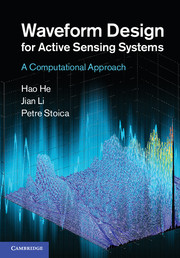Book contents
- Frontmatter
- Contents
- Preface
- Notation
- Abbreviations
- 1 Introduction
- Part I Aperiodic correlation synthesis
- Part II Periodic correlation synthesis
- Part III Transmit beampattern synthesis
- Part IV Diverse application examples
- 16 Radar range and range–Doppler imaging
- 17 Ultrasound system for hyperthermia treatment of breast cancer
- 18 Covert underwater acoustic communications – coherent scheme
- 19 Covert underwater acoustic communications – noncoherent scheme
- References
- Index
19 - Covert underwater acoustic communications – noncoherent scheme
from Part IV - Diverse application examples
Published online by Cambridge University Press: 05 August 2012
- Frontmatter
- Contents
- Preface
- Notation
- Abbreviations
- 1 Introduction
- Part I Aperiodic correlation synthesis
- Part II Periodic correlation synthesis
- Part III Transmit beampattern synthesis
- Part IV Diverse application examples
- 16 Radar range and range–Doppler imaging
- 17 Ultrasound system for hyperthermia treatment of breast cancer
- 18 Covert underwater acoustic communications – coherent scheme
- 19 Covert underwater acoustic communications – noncoherent scheme
- References
- Index
Summary
In Chapter 18 we discussed covert UWA communications with a coherent RAKE receiver, in which case the CAN or WeCAN sequences were shown to be the probing waveforms of choice. As pointed out before, low chip SNR communication over a timevarying UWA channel precludes accurate channel estimation. This could render coherent detection schemes ineffective [Smadi & Prabhu 2004][Yang & Yang 2008] and thus make noncoherent schemes more favorable. In this chapter we examine covert UWA communications with noncoherent schemes and the waveform design issues thereof. More specifically, two types of noncoherent transceiver designs are addressed: orthogonal modulation and differential phase-shift keying (DPSK), both coupled with a DSSS technique and a noncoherent RAKE reception [Brennan 1959]. Although only binary information sequences are considered here, the derivations can be easily extended to a general M-ary case.
For orthogonal modulation, spreading waveform sets with low correlation properties (both auto- and cross-correlation) such as the Gold sequence set [Gold 1968] are desired for combating the multipath nature of UWA channels. For DPSK modulation, a common design is to adopt the cyclic prefix so that the receiver can eliminate the intersymbol interference by ignoring the prefix chips before proceeding with symbol detection [Pursley 1977][Tse & Viswanath 2005]. Such a design requires waveforms with low or even zero periodic correlations over certain lags, an example of which is the Frank sequence (see (1.23)). However, the aforementioned sequences (the Gold and Frank sequences) belong to the class of unimodular polyphase sequences that are constructed from fixed formulas with restricted lengths and/or fixed phase constellations.
- Type
- Chapter
- Information
- Waveform Design for Active Sensing SystemsA Computational Approach, pp. 280 - 300Publisher: Cambridge University PressPrint publication year: 2012



